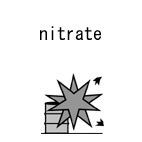| Case Name |
Explosion caused due to a leakage of a heat medium (nitrate) through a crack in the reactor at a phthalic anhydride manufacturing plant |
| Pictograph |

|
| Date |
October 15, 1957 |
| Place |
Ota, Tokyo, Japan |
| Location |
Chemical factory |
| Overview |
A strong explosion occurred at a phthalic anhydride manufacturing plant during usual operation. Nitrate used as a heat transfer medium of the reactor leaked out from a crack near the mounting weld part, mixed with a black tarry material which was generated in the reactor, and exploded. The reactor had been used for six years, the tarry material had accumulated, and corrosion was also severe. Hazard evaluation of the reaction by-product was not done sufficiently. |
| Incident |
A strong explosion occurred near the first heat exchanger, which was connected to the reactor during usual operation of a phthalic anhydride manufacturing plant. |
| Processing |
Manufacture |
| Individual Process |
Reaction |
| Process Flow |
Fig2.Unit process flow
|
| Chemical Reaction |
Oxidation |
| Chemical Equation |
Fig3.Chemical reaction formula
|
| Substance |
Nitrate |
| Type of Accident |
Leakage, explosion |
| Sequence |
Vaporized naphthalene with air was sent to the reactor to be converted into phthalic anhydride in the phthalic anhydride manufacturing plant. As this reaction was done at a high temperature of about 400 °C, the reaction product was collected by cooling in the crystal chamber. A strong explosion occurred near the first heat exchanger which was connected to the reactor during usual operation, the reactor tumbled down, and the plant was completely destroyed. The windows of residences and a hospital about 200 meters away were damaged. |
| Cause |
The cause of the explosion was presumed to be as follows. The nitrate used as a heat transfer medium in the reactor leaked out from a crack near the mounting weld part of the catalyst filling tube of the reactor. It flowed into the heat exchanger downstream, and it accumulated near the lower tray board. After the nitrate was mixed with black tarry impurities which adhered to the wall and so on, the mixture exploded. The reactor had been used for six years, tarry material adhered, and corrosion was also severe. |
| Countermeasures |
Re-study of materials and processing methods of the reactor, strengthening of maintenance. |
| Knowledge Comment |
Nitrate used as a heat transfer medium might become an oxidizing agent. If nitrates are used, the mixing hazard of leaked nitrate must be taken account of in the process design and the material selection. |
| Background |
The main factors were the crack and continuing of operation without noticing it. It was confirmed that black tarry impurities generated an strong explosion near 300 °C when heated with nitrates. The reaction by-product of this black tarry material had solidified in large amounts and was not cleaned off.
There was an indication that the reactor had not been inspected, and it seemed that there was a very poor sense of danger. |
| Reason for Adding to DB |
Example of explosion accident caused due to hazardous by-products |
| Scenario |
| Primary Scenario
|
Insufficient Analysis or Research, Insufficient Prior Research, Effect of very small amount product, Poor Value Perception, Poor Safety Awareness, Inadequate Safety Countermeasure, Planning and Design, Poor Planning, Poor Design, Usage, Maintenance/Repair, Insufficient Inspection, Failure, Fracture/Damage, Crack, Secondary Damage, External Damage, Explosion, Bodily Harm, Injury, 3 person injured, Loss to Organization, Economic Loss, Direct Monetary Damage 24 million yen
|
|
| Sources |
Japan Assoc. of Fire Science and Engineering, Chemical fire committee C.3.1, Phthalic anhydride. Case 118, Chemical fire examples (1), p.143(1971)
Masamitsu Tamura, Masahide Wakakura, Explosion during phthalic anhydride manufacturing. Reaction danger. -Accident case and analysis-, p.50(1995).
|
| Number of Injuries |
3 |
| Physical Damage |
The plant was completely destroyed. The windows of residences and a hospital about 200 meters away were damaged. |
| Financial Cost |
¥ 24 million |
| Field |
Chemicals and Plants
|
| Author |
ARAI, Mitsuru (Environmental Science Center, The University of Tokyo)
TAMURA, Masamitsu (Center for Risk Management and Safety Sciences, Yokohama National University)
|
|